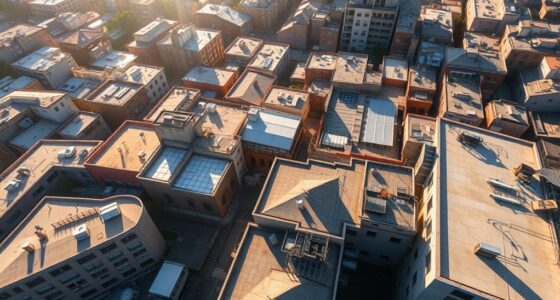Agri-photovoltaics let you farm under solar panels, giving you a double harvest—electricity and crops—on the same land. You’ll need to plan panel placement carefully to maximize sunlight for your crops while capturing solar power efficiently. Selecting shade-tolerant crops helps optimize both yields. This approach reduces water use, cuts energy costs, and promotes sustainability. Stay with us to discover how you can design and manage a successful agri-PV system tailored to your farm.
Key Takeaways
- Agri-PV combines solar energy production with traditional farming, enabling dual land use for crops and electricity.
- Proper panel layout and height optimize sunlight exposure, preventing shading and maximizing crop and energy yields.
- Selecting shade-tolerant crops like leafy greens ensures productivity under solar panels.
- This system reduces water evaporation and irrigation needs, promoting water conservation and crop growth.
- Agri-PV offers economic benefits by lowering energy costs and environmental advantages through renewable power generation.

Agri-photovoltaics (Agri-PV) combine solar energy production with traditional farming, allowing you to generate electricity without sacrificing crop cultivation. This innovative approach involves installing solar panels above your crops, creating a dual-use system that maximizes land efficiency. When planning your solar panel installation, consider the layout carefully to ensure that the panels are positioned at the optimal height and angle. This way, you can prevent shading that might reduce your crop yield and ensure that both energy and produce thrive. Properly designed Agri-PV setups help you optimize crop yield by balancing sunlight exposure. You don’t want panels to cast too much shade on your plants, as this could slow growth or reduce quality. Instead, you aim for a configuration that provides enough shade to lower water evaporation and moderate temperature extremes, but still allows sufficient sunlight for your crops to flourish.
As you implement your solar panel installation, think about the crop varieties you’re growing. Some crops tolerate partial shade better than others, and selecting these can enhance your overall productivity. For example, leafy greens and certain vegetables often do well under the partial cover of solar panels, whereas fruiting plants might need more direct sunlight. You’ll also want to consider the spacing between panels, which impacts both the amount of sunlight reaching your crops and the efficiency of your energy generation. The goal is to find a sweet spot where your panels are productive without compromising the health and yield of your crops.
By integrating solar energy into your farming system, you’re not only generating renewable power but also potentially reducing costs. Solar panel installation can offset your energy bills, especially if your farm consumes significant electricity for irrigation, equipment, or processing. Additionally, the shading provided by the panels can help conserve water by lowering evaporation rates, therefore reducing your irrigation needs and further boosting crop yield optimization. This synergy allows you to create a more resilient, sustainable farm that benefits from both energy and crop production.
Ultimately, the success of your Agri-PV system depends on your careful planning and ongoing management. Regularly monitor how your crops respond to the shading and adjust panel positioning or crop choices accordingly. With thoughtful design and maintenance, you can enjoy a double harvest—energy and produce—maximizing land use and sustainability. Incorporating tuning techniques from related fields can further enhance the efficiency and performance of your system, ensuring long-term success. This approach not only enhances profitability but also supports a greener future for agriculture.
Frequently Asked Questions
What Crops Benefit Most From Agri-Photovoltaics?
You’ll find that crops with high crop synergy and good solar compatibility benefit most from agri-photovoltaics. Leafy greens, herbs, and strawberries thrive because they don’t block too much sunlight and can adapt to partial shade. These crops benefit from the microclimate created by solar panels, enhancing growth while maximizing land use. You’ll notice improved yields and sustainable farming practices, making this approach ideal for efficient, eco-friendly agriculture.
How Does Shading From Solar Panels Affect Crop Growth?
Imagine you’re in the Renaissance, pondering how solar panels might influence crops. Shading from solar panels reduces light intensity, which can hinder crops with low shade tolerance, slowing their growth. However, some crops thrive under partial shade, benefiting from moderated temperatures and reduced water loss. You need to contemplate each crop’s shade tolerance to optimize growth, ensuring the shading benefits outweigh any negative impacts on light availability.
What Is the Typical Cost of Installing Agri-Photovoltaic Systems?
When considering the cost estimation for installing agri-photovoltaic systems, you should know that installation expenses vary based on system size, location, and technology. Typically, you might expect costs ranging from $1,000 to $3,000 per kilowatt, including equipment and labor. Keep in mind that initial investment can be offset by long-term savings and potential subsidies. Planning carefully helps you manage installation expenses and optimize your system’s benefits.
How Do Agri-Photovoltaics Impact Water Usage and Irrigation?
Think of agri-photovoltaics like a shield that conserves water; they reduce water usage by providing shade and lowering evaporation. You’ll notice improved irrigation efficiency because crops stay healthier with better moisture control. These systems help you save water, making your irrigation more sustainable while maintaining or even boosting crop yields. Overall, they support water conservation efforts and promote more efficient farming practices under changing climate conditions.
Are There Any Government Incentives for Adopting Agri-Photovoltaics?
You might find that government grants and policy incentives encourage adopting agri-photovoltaics. Many governments offer financial support, tax breaks, or subsidies to promote renewable energy and sustainable farming. These incentives aim to make it more affordable for you to install solar panels over farmland, boosting both crop yields and energy production. Checking local policies can help you identify specific grants or incentives available in your area to support your changeover.
Conclusion
You’ve seen how agri-photovoltaics can boost your farm’s productivity and sustainability by combining farming with solar energy. This innovative approach proves that “a stitch in time saves nine,” meaning early adoption can prevent future problems and maximize benefits. Embracing this technology not only helps you grow crops and generate power but also supports a greener future. So, why wait? It’s time to plant the seeds for double harvests and a brighter tomorrow.









